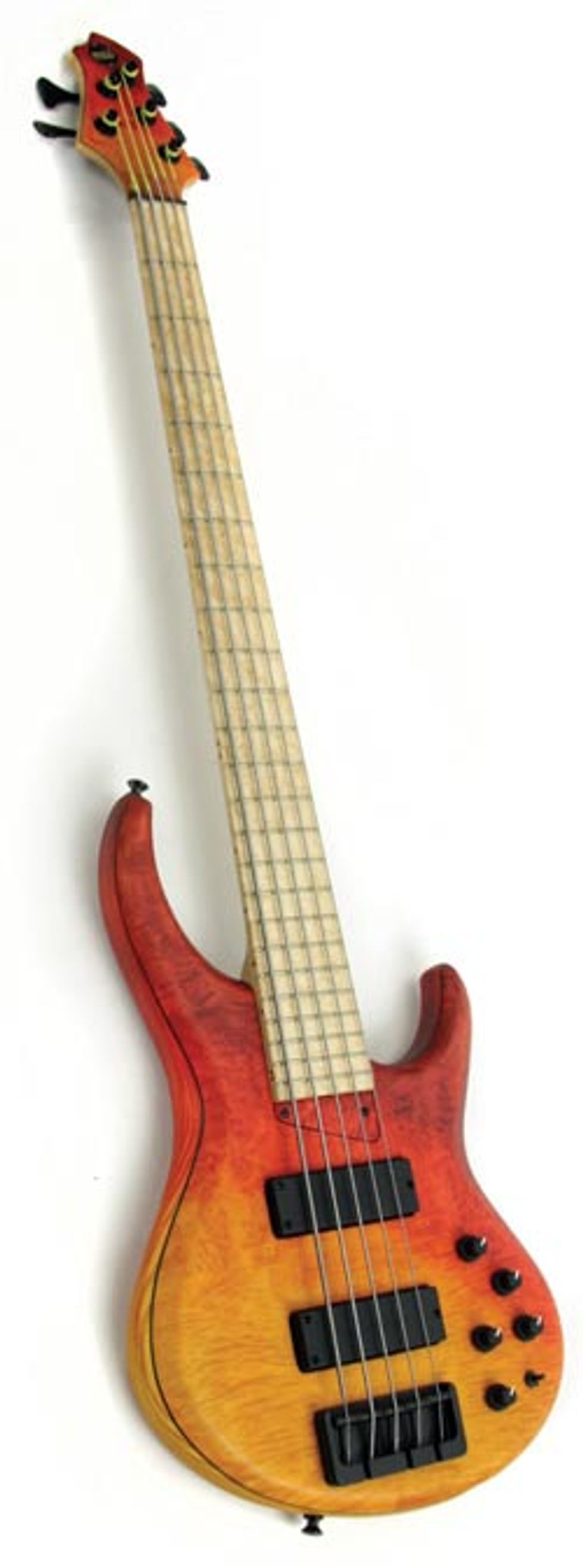Michael Tobias Design''s 545-24 is a top-notch instrument for discerning bassists
 | |
| Download Example 1 Slap - boosted treble and bass and favored neck pickup slightly | |
| Download Example 2 Blues - boosted mids at 250, boosted bass slightly, cut treble slightly, neck pickup. | |
| Download Example 3 Solo - boosted mids at 500, cut treble moderately, bridge pickup, played over bridge pickup. | |
| Recorded into an AxePort Pro into GarageBand with no effects. | |
Choosing Wood for Form and Function
The MTD 535-24 is designed and built by one of the founding fathers of American boutique electric basses, Michael Tobias. (Just to be clear, we are talking here about the handmade American model rather than the imported MTD Kingston).
The bass I received for review has an ash body and a maple burl top, with a beautiful red-to-orange-fade stain. Its finish includes an epoxy base coat and a catalyzed urethane topcoat that looks like oil but is much more durable. This makes for a thin finish, allowing the wood to remain as lively as if it were naked. Speaking of… the curves of the body are sensuous and round, the waist cutaway deep and comfortable, the feel of the wood warm and smooth. Mmmmm.
This bass also has an optional matching headstock and truss-rod cover plate. On the rear of the bass, cover plates for the control cavity and battery holder were matched to the orange-stained grain pattern. The ash grain on the back was stunning, a two-piece book-matched body with close stripes in the center spreading out to wider grain on the edges. As you would expect for an instrument at this level, both removable covers used machine screws and threaded inserts for long-term durability.
Little design details stood out, too. The upper horn, for example, was subtly flattened at the end to help the strap button fit flush and snug. The other strap button was located a little higher than usual, helping create a nice strap balance. The jack was placed on the body edge, but not on the lower curve like most basses. Instead, it was placed a couple of inches below the body’s centerline, angled upward so that if you sit down and play, the plug doesn’t mash into your seat. It’s a great ergonomic detail that should be standard on all basses that mount the jack on the body edge.
In Another Neck of the Woods
The neck deserves special attention, too. This one was made from ash rather than the usual maple. The quarter-sawn grain ran beautifully along the length of the neck. On top, the fingerboard was capped with bird’s eye maple— another really beautiful piece of wood. In all, its beauty was striking yet subtle.
But a good neck does not get by on looks alone. MTD includes nuances that make it a great playing, functional neck as well. At first, this 35” scale (an inch longer than standard), 5-string bass had me a little worried, especially with its full 19mm spacing between strings and 24 vintage-style frets. Yes, the scale did throw off my muscle memory, but that was only a temporary challenge.
When I began to play the MTD 535-24, the strings rattled quite a bit under just a moderate fingerstyle attack. A steel rule measured the action at around 2/32” and near-zero relief. I’ve never found a bass that could avoid rattles with action that low. After bringing the lower strings up to 3/32” and adding a tad of relief, the action still felt very fast but the rattles were gone (the taper-core B string required really raising that bridge saddle).
Overall, the four-bolt neck had a wide-thin feel, shaped so it just melted into my hand. Reaching to the G string was easy and natural. Almost every bass I’ve played has a bit of fret edge that you bump into on the way up and down the neck. But on this neck, it was like the fret edges weren’t even there. The Buzz Feiten tuning system made intonation clean and true. And the body-neck heel joint tapered very smoothly—not your usual cliff jumping between body and neck.
Neck + Body = ?
As I said, the wood choices certainly look great, but they’re all aimed toward a specific sonic purpose. The combination of woods on this bass was chosen to create a clean, aggressive sound, with a bright top, strong mids and a good, useable bottom end—rather piano-like.
I have to agree that the design goals were achieved, but really, that over-simplifies what the bass can do—more on that in a moment. The note attack was exceptionally well defined, clear but not brittle, with even tone from low B to way up the G string.
This combination of neck and body woods helped the stainless steel strings really ring out with fantastic harmonics and sustain. This model has a strong following among slappers, and for good reason: it almost asks for slap-and-pop playing. And it’s a very easy bass to play, almost like it plays itself.
Great Hardware = Total Package
Regarding hardware, the Hipshot Ultralight tuners and minimalist quick-release bridge helped keep the weight down. The neck bolts were nicely recessed, and the two-way truss-rod turned easily and smoothly.
I’ve had Bartolini pickups on a couple of basses and have found them to sound very transparent. That was certainly the case here, with both the neck and bridge pickups producing just what I heard from the bass acoustically. Even though the bass tended toward a modern funk sound, it could be taken in lots of other directions. Controls are laid out logically, so you’ll grab the right knob the first time.
On the top row, from neck to bridge, are the Volume and Pickup Blend knobs, with a center detent on the blend knob. The lower row of controls includes Treble, Midrange and Bass knobs, plus a three-way toggle for choosing a midrange center (250hz, 500hz, 1000hz). All three tone controls are cut/boost with a center detent (and behind them in the control cavity is an exemplary job of copper foil shielding!).
Between the ability to blend the two pickups, switch the midrange center, and cut/ boost the tone controls, an amazing tonal variety can be found. Flip the midrange switch down to 250hz, turn up the midrange boost and favor the neck pickup for a fat, old school sound. Boost the treble and bass for a great slap tone that’s naturally compressed. To go Jaco, solo the bridge pickup, bump the mids at 500hz and play over the bridge pickup—full tilt burpsville!
The Final Mojo
If you’re looking for a truly fine instrument that tends toward the modern, the MTD 535-24 is an excellent choice. It’s a comfortable instrument where design elements are executed with finesse. One small quibble is that the battery cover is held on by screws that do not have a keeper; you could easily lose a screw while changing batteries in a hurry on stage. And with no preamp bypass, if the batteries die, you would need to do a change on the fly. Still, I expect the two-battery system to get a lot of hours between changes. If you can afford a bass of this caliber, you can also afford to make battery changes a regular habit.
Buy if...
you've been looking for a fine instrument with excellent ergonomics and a wide tonal palette that suits a variety of playing styles.
Skip if...
you're a meat-and-potatoes players and most of your gigs are in settings that put a fine instrument at risk.
Rating...
List $4400 (basic instrument) $6190 (with case and options) - Michael Tobias Design - mtdbass.com |


